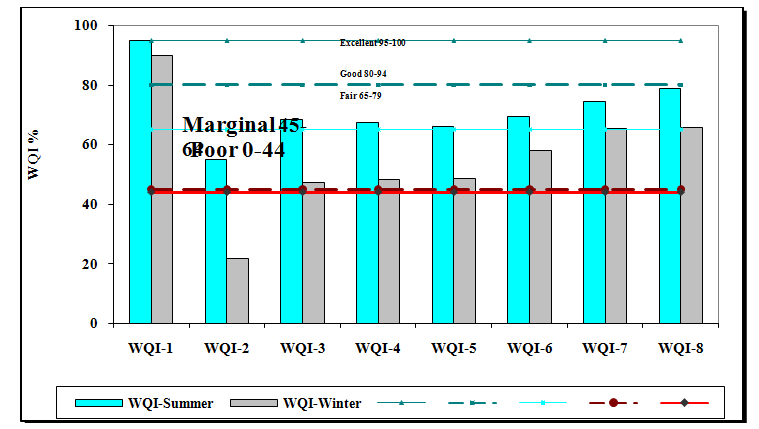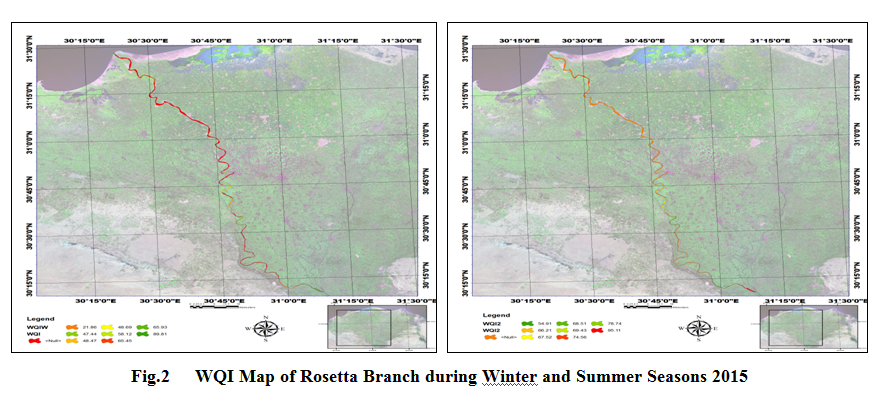Mapping of Quality Index and Pollution Risk along Rosetta Branch using GIS Techniques
Abd El-Gawad HS1, Azzazy MF2*, El-Hattab MM2, Hasseb TZ1
1Central Laboratory for Environmental Quality
Monitoring (CLEQM), National Water Research Center (NWRC), El-Kanater,
Qalubiya, Cairo, Egypt
2Natural Resources Survey Department, Institute
of Environmental Studies and Research, University of Sadat City, Egypt
*Corresponding author: Mohamed Azzazy, Natural Resources Survey Department, Institute
of Environmental Studies and Research, University of Sadat City, P.O. Box
13621/6, Egypt. Tel: +202482603208; +202482602178; Email: mohamed.azzazy@esri.usc.edu.eg
Received
Date: 05 April, 2018; Accepted
Date: 24 April, 2018; Published Date: 04
May, 2018
Citation: Abd El-Gawad HS, Azzazy MF, El-Hattab MM, Hasseb TZ (2018) Mapping of Quality Indexand Pollution Risk along Rosetta Branchusing GIS Techniques. Arch Environ Sci Environ Toxicol: AESET-101. DOI: 10.29011/AESET-101. 10000
The present study focused on assessment surface water quality
along Rosetta Branch using Canadian Council of Ministers of the Environment
Water Quality Index (CCME-WQI) supported by Egyptian guidelines of law 48/1982
decision 92/2013. Rosetta Branch received most pollutants from two hot spots
namely: El-Rahawy drain and industrial activities in Kafr El-Zayat city. The
water quality of eight sites-the main surface water resource for Delta Barrage,
Edfina Barrage, Rahway, Sable, Tharir, Zawieyt El-bahr, Tala drains outfall and
outlet of Rosetta Branch on Mediterranean Sea were investigated. The Geographic
Information System (GIS) was used for mapping the WQI variations in different
sites. The results of the index average for different sites location at each
site showed that the water quality in the studied sites ranked as marginal or
fair. This is attributed to the fact of the concentrations of heavy metals,
ammonia and organic matter increase in sites that are more affected by drainage
water from different drains in the study area. Great efforts are needed, and
wastewater must be treated before draining it into the River Nile water.


Figure 1: Values of WQI for eight locations along Rosetta branch 2015.

|
No. |
Site Code |
Description of Locations |
|
1 |
WQI-1 |
Rosetta Branch - Delta Barrage - Reference Point |
|
2 |
WQI-2 |
Outlet of Rahway drain western Rosetta branch |
|
3 |
WQI-3 |
Rosetta Branch - outlet of Sable drain eastern Rosetta branch |
|
4 |
WQI-4 |
Outlet of Tharir drain western Rosetta branch |
|
5 |
WQI-5 |
Outlet of Zawieyt El-bahr drain western Rosetta branch |
|
6 |
WQI-6 |
Outlet of Tala drain eastern Rosetta branch |
|
7 |
WQI-7 |
Rosetta Branch - Edfina Barrage |
|
8 |
WQI-8 |
Outlet of Rosetta Branch on Mediterranean Sea |
Table 1: Description for Sites Location along Rosetta Branch.
|
No. |
Parameters |
Guidelines |
|
1 |
pH |
6.5-8.5 |
|
2 |
DO-mg/l |
6 |
|
3 |
TDS-mg/l |
500 |
|
4 |
NH4-mg/l |
0.5 |
|
5 |
NO3-mg/l |
2 |
|
6 |
BOD-mg/l |
6 |
|
7 |
COD-mg/l |
10 |
|
8 |
Cd-mg/l |
0.001 |
|
9 |
Cu-mg/l |
0.01 |
|
10 |
Fe-mg/l |
0.5 |
|
11 |
Mn-mg/l |
0.2 |
|
12 |
Zn-mg/l |
0.01 |
|
13 |
Pb-mg/l |
0.01 |
|
14 |
Ni-mg/l |
0.02 |
Table 2: Water quality variables and their Egyptian environmental guidelines.
|
No. |
Code |
Longitude (North) |
Latitude (East) |
Eastward-X (m) |
North-Y (m) |
||||
|
1 |
D1 |
30° |
5" |
11' |
1" |
7' |
31° |
3340716.57 |
318697.48 |
|
2 |
D2 |
30° |
24" |
12' |
00" |
2' |
31° |
3343317.78 |
310703.06 |
|
3 |
D3 |
30° |
8" |
32' |
6" |
51' |
30° |
3380092.48 |
293908.76 |
|
4 |
D4 |
30° |
24" |
36' |
48" |
47' |
30° |
3388053.38 |
288790.48 |
|
5 |
D5 |
30° |
50" |
42' |
39" |
45' |
30° |
339999.40 |
285596.51 |
|
6 |
D6 |
30° |
1" |
49' |
48" |
48' |
30° |
3411524.41 |
286691.87 |
|
7 |
D7 |
31° |
20" |
18' |
9" |
31' |
30° |
3466123.48 |
263900.76 |
|
8 |
D8 |
31° |
48" |
27' |
3" |
22' |
30° |
3483961.92 |
249857.69 |
Table 3: Geographic and Mercator coordinates of sampling sites in Rosetta branch.
|
CCME-WQI Value |
Score |
Remarks |
|
95 - 100 |
Excellent |
Water quality is protected with a virtual absence of threat or impairment; conditions very close to natural or pristine levels |
|
80 - 94 |
Good |
Water quality is protected with only a minor degree of threat or impairment; conditions rarely depart from natural or desirable levels |
|
65 - 79 |
Fair |
Water quality is usually protected but occasionally threatened or impaired; conditions sometimes depart from natural or desirable levels |
|
45 - 64 |
Marginal |
Water quality is frequently threatened or impaired; conditions often depart from natural or desirable levels |
|
0.0 - 44 |
Poor |
Water quality is almost always threatened or impaired; conditions usually depart from natural or desirable levels |
Table 4: CCME-WQI categories.
|
Site Code |
WQI-Summer |
Rating |
WQI-Winter |
Rating |
|
WQI-1 |
95.11 |
excellent |
89.81 |
good |
|
WQI-2 |
54..91 |
marginal |
21.86 |
poor |
|
WQI-3 |
68..51 |
fair |
47.44 |
marginal |
|
WQI-4 |
67..52 |
fair |
48.47 |
marginal |
|
WQI-5 |
66.21 |
fair |
48.69 |
marginal |
|
WQI-6 |
69.43 |
fair |
58.12 |
marginal |
|
WQI-7 |
74.56 |
fair |
65.45 |
fair |
|
WQI-8 |
78.74 |
fair |
65.93 |
fair |
Table 5: Values of WQI for 2015 seasons.
- Chang-An Yan, Wanchang Zhang, Zhijie Zhang, Yuanmin Liu, Cai Deng, et al. (2015) Assessment of water quality and identification of polluted risky regions based on field observations & GIS in the Honghe river watershed, China. PLoS One: 10.
- Jonnalagadda SB, Mhere G (2001) Water quality of the Odzi River in the eastern highlands of Zimbabwe. Water Rese 35: 2371-2376.
- Elewa AA, Shehata MB, Mohamed LF, Badr MH, Abdel-Aziz GS (2009) Water quality characteristics of the River Nile at delta barrage with special reference to Rosetta Branch. Global J Environ Res 3: 1-6.
- Donia N (2005) Rosetta branch waste load allocation model. 9th International Water Technology Conference, IWTC9, Sharm El-Sheikh, pp. 277-288.
- Varol M, Gökot B, Bekleyen A,Sen B (2011) Water quality assessment and apportionment of pollution sources of Tigris River (Tukey) using, multivariate statistical techniques-A case study. River Res App l28: 1428-1438.
- Xu ZX (2005) Comprehensive water quality identification index for environmental quality assessment of surface water. J Nat Sci 33: 482-488.
- Shankar BS, Sanjeev L (2008) Assessment of water quality index for the groundwaters of an industrial area in Bangalore, India. Environ Eng Sci: 25.
- Lumb A, Halliwell D, Sharma T (2006) Application of CCME water quality index to monitor water quality: A case of the Mackenzie River Basin, Canada. Environ Monit Assess 113: 411-429.
- Radwan M,El-Sadek A (2008) Water quality assessment of irrigation and drainage canals in upper Egypt. Twelfth International Conference on Water Technology, IWTC12, Alexandria, Egypt 1239-1251.
- Ali Khan A, Khan H, Abdel-Gawad S (2008) A real time water quality monitoring network and water quality indices for River Nile. 13th IWRA World Water Congress, Montpellier, France.
- Donia N, Farag H (2010) A waste load model analysis for El Noubariya Canal drinking water abstraction, Egypt. 14th International Conference on Water Technology, IWTC 14, Cairo, Egypt, 675-690.
- Vairavamoorthy K, Yan J, Galgale HM,Gorantiwar SD (2007) IRA-WDS: A GIS-based risk analysis tool for water distribution systems. Environ Model Software 22: 951-965.
- Facchinelli A, Sacchi E, Mallen L (2001) Multivariate statistic a land GIS-based approach to identify heavy metal sources in soils. Environ Pollut 114: 313-324.
- Wan W, Wang S (2013) Areal (2-D) simulation of water flood process in unit well pattern. Int J Chem Petrol Sci 2: 1-10.
- Jiang W, Cai Q, Xu W, Yang M, Cai Y, et al. (2014) Cr (VI) adsorption and reduction by humic acid coated on magnetite. Environ Sci Technol 48: 8078-8085.
- Gong X (2014) Facile formation of nanoparticle patterns by water induced flow of a polymer thin film. Res Adv 4: 54494-54499.
- Jasmin I, Mallikarjuna P (2014) Physicochemical quality evaluation of groundwater and development of drinking water quality index for Araniar River Basin, Tamil Nadu, India. Environ Monit Assess 186: 935-948.

 research article
research article